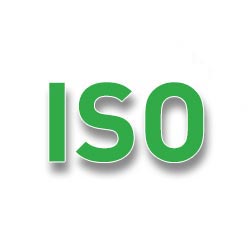
ISO 9001

ISO 9001
What is ISO 9001?
The ISO 9001 standard is an international standard that aims to implement a quality management system in companies and organizations of all sizes, in all sectors of activity.
It is the most requested and recognized certification in the world, with more than one million certified. This standard allows to increase the performance and the competitiveness of the company, to satisfy the customers, to involve the collaborators, and to join a long-term quality approach.
What are the levers involved?
It defines specific requirements for the quality management system, based on principles such as :
- Management involvement
- Customer orientation
- Staff involvement
- Process approach, system approach, continuous improvement, evidence-based decision making, and mutually beneficial supplier relationships.
What are the benefits of certification?
It provides proof of the organization's performance in the areas of quality, occupational health and safety and environmental management. The ISO 9001 standard offers many advantages such as :
- Increased customer confidence
- Cost reduction
- Staff involvement
- Progressive approach
- Removal of trade barriers and international recognition
What are the modalities?
he certification is valid for 3 years and to obtain the certification, it is recommended that the quality management system has been in place for at least 6 months, that it has been audited internally at least once, and that a management review has been performed.

ISO 14001

ISO 14001
What is ISO 14001?
The ISO 14001 standard is a voluntary international standard that aims to implement an Environmental Management System in companies and organizations of all sizes and in all sectors of activity.
What are the levers involved?
The ISO 14001 standard defines specific requirements for an environmental management system (EMS) that allows an organization to:
- Determine its significant environmental impacts
- Develop an environmental policy
- Establish objectives
- Take into account regulatory requirements
- Establish processes that allow it to respect the commitments expressed in this environmental policy
- Take the necessary actions to improve its environmental performance
Like ISO 9001 and ISO 50001, it is part of the management system standards based on the principle and approach of continuous improvement (of environmental performance for ISO 14001).
What are the modalities?
The validity period of the ISO 14001 : Environmental Management System certification is 3 years, subject to the completion of annual surveillance audits.
The renewal of the certification requires a renewal audit, which is carried out by a different auditor and which aims to confirm that there is no major non-conformity.
The requirements of an EMS are divided into 18 environmental requirements and 6 chapters, including:
- General requirements
- Environmental policy
- Planning
- Implementation of actions to comply with the environmental policy
- Controls and corrective actions
- Management review
What are the benefits of certification?
The implementation of the ISO 14001:2015 standard aims to:
- Control the environmental impact of your activities
- Develop an environmental policy
- Demonstrate your involvement in the preservation and protection of the environment on a global scale.
Benefits for the ISO 14001 certified organization:
- Identification of the environmental aspects of your activities, products and services.
- Reduction of nuisances.
- Compliance with regulatory requirements.
- Transparent communication with employees, local residents, customers, environmental associations, elected officials, insurers...
- Enhancement of your image
- Opening towards new markets
- The certification of your environmental management system (EMS) according to the ISO 14001 standard allows you to prove your environmental involvement on a worldwide level.

ISO 45001

ISO 45001
What is the ISO 45001?
ISO 45001 is an international standard that aims to implement an Occupational Health and Safety (OHS) management system and establish objectives taking into account legal requirements and information on OHS risks.Actively promote the implementation and awareness of integrated QSE (Quality, Safety and Environment) approaches.
What are the levers involved?
- OHS management system planning and policy
- Risk management
- Training and awareness of occupational health and safety risks and prevention and protection measures
- Management's commitment to provide the necessary resources to ensure its effectiveness.
- Continuous improvement of the OHS management system
What are the benefits of certification?
- Manage risks in a global and structured way
- Reduce the number of work accidents of your employees
- Reduce the direct and indirect costs of your organization (business interruptions, insurance premiums...)
- Increase productivity and performance through better working conditions (less absences, lower staff turnover rate...).
- Demonstration of your commitment to improving the health and safety of your employees.
- Improvement of your image with your partners, clients and customers.
What are the modalities?
- That your Occupational Health and Safety management system has been in place for 6 months,
- That your Occupational Health and Safety management system has also been audited internally at least once,
- That a management review has been carried out.

ISO 50001

ISO 50001
What is the ISO 50001 standard?
The ISO 50001 standard is a voluntary international standard that aims to develop and implement a systematic energy management system to focus on energy performance.The certification of your energy management system according to the ISO 50 001 standard allows you to prove that you comply with the energy efficiency policy you have set. This certification request is part of your quality, CSR and environmental policy.
What are the levers involved?
The ISO 50 001 standard defines specific requirements for an energy management system, allowing an organization to:
- Develop and implement a more efficient energy policy
- Establish objectives, targets and action plans to meet the commitments expressed in this policy
- Measure the results of the energy policy based on data
- Take the necessary measures to continuously improve its energy performance.
It contributes to the implementation of a continuous improvement process, which will result in a more efficient use of available energy sources, better competitiveness and a reduction of greenhouse gases. It encourages the implementation of an energy monitoring plan and energy analyses.
What are the benefits of certification?
The implementation of ISO 50 001:2018 aims to:
- Enable organizations to establish the systems and processes necessary to improve energy performance.
- Particularly in relation to energy efficiency, usage and consumption.
- Lead to a decrease in greenhouse gas emissions and energy-related costs.
- Identify potential energy savings.
- Implement an action plan.
- Involve all staff in a unifying project
The certification of your energy management system according to the ISO 50 001 standard allows you to prove that you comply with the energy efficiency policy you have set.
What are the terms and conditions?
The ISO 50 001 certification is valid for 3 years under the conditions of annual surveillance audits. Renewal of the certification requires a renewal audit, which is carried out by a different auditor.
In order to present yourself for certification in the best conditions, to facilitate obtaining it and to better meet the requirements of the ISO 50 001 standard, we recommend
- That your energy management system has been in operation for 6 months
- That it has been audited internally at least once.
- That a management review has been carried out.

ISO 22000

ISO 22000
What is ISO 22000?
ISO 22000 outlines the requirements for an effective food safety management system. It is designed to help organizations ensure the safety of their food products throughout the entire food chain, from production to consumption.
What are the levers involved?
- Identifying potential hazards that could occur in the food production process.
- Establishing critical points in the process where controls can be applied to prevent or eliminate food safety hazards.
- Integrating food safety with the overall management system of the organization.
- Setting up basic conditions and activities necessary to maintain a hygienic environment throughout the food chain.
- Ensuring effective upstream and downstream communication about food safety issues within the food chain.
What are the modalities?
The ISO 22000 certification is valid for three years, subject to annual surveillance audits to ensure ongoing compliance. It includes:
- Development and implementation of a tailored food safety management system.
- Creating and maintaining records that document the implementation of the food safety management system.
- Systematic planning and realization processes that uphold food safety.
- Continuous assessment and improvement of the food safety management system to enhance food safety outcomes.
What are the benefits of certification?
- Minimizes the risk of contamination and increases product safety.
- Helps comply with legal and statutory food safety requirements.
- Boosts confidence among consumers, suppliers, and other stakeholders.
- Integrates with other management systems, which can improve operational efficiency.
- Facilitates entry into new markets where customers demand adherence to food safety standards.
- Provides a systematic approach to managing food safety risks, protecting both the company and the public.
Focus on ISO 9001

Contact us
Why Choose
Apave India ?

Our customer relationship approach

Our competitive prices





